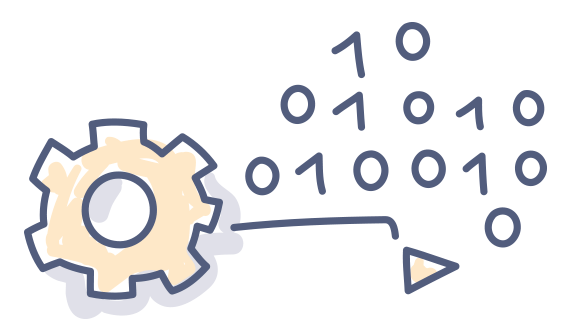Computer Assisted Coding (CAC)
Computer assisted coding sometimes referred to as CAC coding or CAC medical coding is reshaping the way healthcare providers approach medical coding accuracy. By leveraging natural language processing, machine learning, and other AI in healthcare technologies, CAC coding enables healthcare organizations and health information systems to streamline coding processes and enhance accuracy in patient care. With its ability to quickly locate relevant information from unstructured data sets such as medical records, CAC coding and CAC software helps healthcare organizations maximize efficiency and reduce costs associated with manual coding processes. Moreover, by providing greater visibility into past treatments and diagnosis, CAC medical coding allows for more consistent coding practices that ensure proper reimbursement for services rendered. As a result of these advantages, computer assisted coding has become an invaluable tool for healthcare professionals who are looking to improve their workflow operations and increase quality outcomes.
What is Computer Assisted Coding Software?
Computer assisted coding CAC in healthcare is a methodology that uses software and powerful medical algorithms to automate the process of assigning appropriate medical codes to medical records. By leveraging automated technologies, medical coding software vendors offering CAC coding systems allow health care organizations to reduce manual coding errors, maintain compliance with legal and reimbursement regulations, accelerate claim processing timeframes, and ultimately improve patient outcomes. CAC coding also helps increase overall cost-efficiency by reducing labor costs associated with manual coding activities. The benefits of using computer assisted coding are tangible – but only when applied correctly. A successful implementation of CAC technology requires accurate data mapping, detailed review processes, and an optimized workflow that meets the needs of your healthcare organization. This ensures the medical coding software is working as efficiently as possible while achieving maximum accuracy in code assignment.
Why Are Medical Coders Using CAC?
Medical coders in healthcare are increasingly turning to CAC tools to enhance their coding efficiency and accuracy. This technology, pivotal in modern healthcare, provides a bridge between healthcare professionals and the intricate world of medical coding.
The computer assisted coding definition encompasses a system designed to read and interpret text-based clinical documents, extracting pertinent information for coding. By leveraging natural language processing and machine learning, CAC tools understand the context of the medical narrative, ensuring that the codes generated are reflective of the documented care. This automation not only streamlines the coding process but also significantly reduces the possibility of human error, a crucial aspect in maintaining the integrity of healthcare data.
What is CAC in healthcare, beyond its basic definition? It represents a transformative approach to managing medical records. These tools facilitate the translation of clinical documentation into standardized codes, which are essential for billing, reporting, and analytics in healthcare. By automating routine tasks, CAC tools allow medical coders to focus on more complex documentation, where their expertise is indispensable. This shift not only improves coding accuracy but also enhances coder productivity, directly impacting the financial health of healthcare organizations.
Moreover, CAC healthcare tools are instrumental in keeping pace with the ever-evolving landscape of medical coding. Healthcare regulations and coding standards are subject to frequent changes, and CAC tools are updated accordingly to reflect these modifications. This ensures that healthcare providers remain compliant with regulatory requirements, avoiding costly errors and denials.
The integration of CAC tools in healthcare is a significant advancement. The essence of CAC in healthcare lies in its ability to augment the capabilities of medical coders, ensuring accuracy, efficiency, and compliance in the coding process. As the computer assisted coding definition continues to evolve with technological advancements, its role in healthcare will undoubtedly become more integral, shaping the future of medical documentation and coding.
Integrating CAC Medical Coding
Electronic health record systems (EHRs) are a major source of electronic documentation. However, it can be a complex process to integrate the data within electronic health records into the coding process. Computer assisted coding provides a crosswalk between the data in the EHR and transcription systems and the practice management system.
CAC medical coding that uses natural language processing technology can analyze and interpret unstructured healthcare data using specialized algorithms, extracting the facts that support the appropriate medical codes assigned. Applications that deal with structured input can integrate the coding into the clinical documentation of health systems and produce clinical documents with codes properly embedded. Most natural language processing technology can work with current clinical documentation practices that produce unstructured data text, such as speech recognition and computer aided medical transcription.
Data interfaces are necessary to provide the clinical documentation into the medical coding software and receive the coded data into the organization's billing system. Interface formats such as HL7 FHIR or XML can be used to distribute the clinical documents. With natural language processing-based platforms, almost any document format can be acceptable.
Web-based services are a popular option for some health information systems implementing CAC, particularly if an existing programming interface or other medical coding automation tools are available. The output of the healthcare coding software workflow is coded records, including the CPT codes and ICD-10 codes needed to file a complete claim, such as code linkage, patient demographics, modifiers and units. The best workflow option should not require data entry at all by transferring the computer assisted coding data directly from the medical coding software into the billing system.
Computer assisted coding CAC does not remove the necessity for medical coding experts to be involved in the health information management process. CAC technology can make medical coders more effective and increase clinical documentation improvement for health systems. Coders can review and revise the medical coding computer requirements, and cross check it against quality metrics and patient data standards in real time.
Today, CAC vendors offer computer assisted coding technology that is most widely used in coding for outpatient services. Some medical specialties using CAC medical coding include radiology, cardiology, pathology and emergency medicine.
Benefits of Medical Coding Software
The integration of medical coding software into health institutions ensures that vast amounts of patient data can be processed rapidly while minimizing the potential for human error. As a result, this helps to improve the accuracy of patient records, billing, and insurance claims – all crucial components that determine the financial health of medical establishments and the broader healthcare system.
One of the primary computer assisted coding benefits is its ability to swiftly analyze EHR data and assign appropriate codes based on its intelligent medical algorithms. This swift automated process significantly reduces the time needed for manual code entry, enabling coders to handle larger volumes of data in shorter timeframes. Furthermore, the standardized nature of medical coding software ensures a higher level of consistency in code assignment, which is pivotal in reducing claim denials due to coding inaccuracies.
Beyond the tangible computer assisted coding benefits it also play a significant role in improving overall patient care. By ensuring that patient records are accurately coded and processed, healthcare providers can guarantee that treatments and diagnoses are consistent with the patient's medical history. The integration of medical coding software also facilitates the smooth exchange of medical data between institutions, leading to more coordinated and informed healthcare decisions. Overall, the adoption of CAC systems, powered by sophisticated medical coding software, stands as a testament to the continuous evolution of the healthcare sector towards enhanced efficiency and patient-centered care.
What to Look for in Medical Coding Software Vendors
Finding computer aided coding software that fits into your coding workflow can be a challenge. Computer assisted coding applications offered by CAC vendors should integrate with other clinical and administrative applications as seamlessly as possible. Medical coding software vendors offering computer assisted coding features in their products should increase results in the following areas for their users:
Performance
When the average amount of time to code a case decreases, performance increases. An increase in productivity with CAC medical coding results in the speeding up or elimination of tedious tasks within the coding process, such as document sorting, checking for duplicates, code lookup and manual data entry.
Correctness
When the coding output matches both the official standards and the payer reporting standards, accuracy improves. Accuracy improvements occur when there’s a decrease in denials, reduction in audits, or discovering charges that were previously missed. Increasing correctness using medical coding software assures that all of the charges that an organization is entitled to collect are properly captured.
Consistency
Consistency in coding provides a standard to be used over time and across multiple coding assets. Healthcare coding software can produce a higher level of consistency and confidence in the results. Consistent clinical and financial data results in better analysis for future decision making.
Transparency
Evidence of both the workflow and thought processes that went into the coding results enhances transparency. Computer aided coding software may include links between the codes assigned and the data in the patient records that supports it.
Compliance
A prospective coding process encourages a “get it right the first time” approach that reduces additional work at time of claim submission. Medical coding software vendors that offer improvements in compliance in their CAC engine products result in accurate and consistent coding in the process. These benefits reduce the prep work for audits, while improving audit results.
Conclusion
Computer assisted coding is a valuable tool for clinical documentation improvement, offering the healthcare industry numerous benefits to enhance their efficiency and coding accuracy. CAC medical coding can significantly reduce the time spent on mundane tasks such as coding claims, allowing medical staff to focus on more important patient care. It also streamlines reimbursements by automatically assigning codes to clinical documentation that are compliant with industry standards, reducing the risk of rejected or delayed payments. On top of that, computer assisted coding provides automated analytics capabilities that give organizations insight into their performance metrics like cost avoidance and clinical outcomes. Ultimately, this helps them identify opportunities for improvement and make data-driven decisions regarding their operations. With all the computer assisted coding benefits, it's no wonder why many healthcare providers are turning to CAC solutions like computer aided coding software to help optimize their workflow.
ForeSee Medical’s computer assisted HCC coding software is designed to increase the profitability of Medicare risk contracts by providing the most accurate and evidence-based HCC codes at the point of care. Our software is intuitive and integrates with most EHRs. By utilizing ForeSee Medical’s AI-powered platform, you'll not only be able to improve your accuracy rate but also reduce administrative time spent on coding. With our comprehensive solution, you can ensure that your HCC coding is accurate and compliant.





